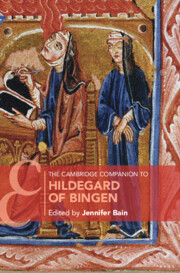Book contents
- The Cambridge Companion to Hildegard of Bingen
- The Cambridge Companion to Hildegard of Bingen
- Copyright page
- Dedication
- Contents
- Figures
- Tables
- Music Examples
- Contributors
- Acknowledgments
- Introduction
- Part I Life and Monastic Context
- Part II Writings and Reputation
- Part III Music, Manuscripts, Illuminations, and Scribes
- Chapter 10 Music, Liturgy, and Intertextuality in Hildegard of Bingen’s Chant Repertory
- Chapter 11 The Ordo virtutum and Benedictine Monasticism
- Chapter 12 Picturing Hildegard of Bingen’s Sight: Illuminating Her Visions
- Chapter 13 Hildegard of Bingen and Her Scribes
- Select Bibliography
- Index
- Cambridge Companions To …
- References
Chapter 10 - Music, Liturgy, and Intertextuality in Hildegard of Bingen’s Chant Repertory
from Part III - Music, Manuscripts, Illuminations, and Scribes
Published online by Cambridge University Press: 28 October 2021
- The Cambridge Companion to Hildegard of Bingen
- The Cambridge Companion to Hildegard of Bingen
- Copyright page
- Dedication
- Contents
- Figures
- Tables
- Music Examples
- Contributors
- Acknowledgments
- Introduction
- Part I Life and Monastic Context
- Part II Writings and Reputation
- Part III Music, Manuscripts, Illuminations, and Scribes
- Chapter 10 Music, Liturgy, and Intertextuality in Hildegard of Bingen’s Chant Repertory
- Chapter 11 The Ordo virtutum and Benedictine Monasticism
- Chapter 12 Picturing Hildegard of Bingen’s Sight: Illuminating Her Visions
- Chapter 13 Hildegard of Bingen and Her Scribes
- Select Bibliography
- Index
- Cambridge Companions To …
- References
Summary
This chapter argues that composing and singing plainchant for the medieval liturgy was enhanced by the creative practice of intertextuality, the citation and referencing of other textual and musical sources. For Hildegard of Bingen, one of the few medieval composers whose plainchants are firmly attributable, this was no exception. This chapter contextualizes the use of her musical compositions in medieval liturgical practice and establishes their interconnectedness with her own works and those of others. The author compares manuscript layout, presentation, and ordering of her plainchants with standard presentations of music in medieval liturgical manuscripts and discusses their liturgical function. Hildegard’s writings about music are considered, in terms of crossover of musical texts and themes within her output as well as her intertextual use of other sources, including biblical passages and Boethius’ De Institutione Musica. Finally, this chapter examines Hildegard’s practice of musical intertextuality through quotation and referencing in her compositions of her own plainchants as well as melodic material from chants commonly used in Office feasts.
Keywords
- Type
- Chapter
- Information
- The Cambridge Companion to Hildegard of Bingen , pp. 209 - 234Publisher: Cambridge University PressPrint publication year: 2021



